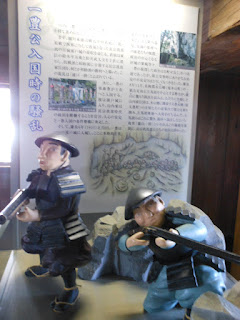I just got home from a very nice weekend in Kochi. The island of Shikoku is made up of 4 prefectures - 'ken' (like states). I live in Tokushima-ken, most of which is in the northeast of the island. I went to Kagawa-ken in the north and north central part of the island, with Kathy last May. Kochi-ken is the southern part of the island and the western part is called Ehime-ken. I'll go to Ehime in a couple of weeks with my cooking teacher whose parents live there and have invited me to spend the night. So one goal, to visit each prefecture on Shikoku will have been accomplished.
Take a look at the map above and locate Kochi at the northern most point of the southern coast, almost in the middle. And notice all the mountains we drove 'through' - LOTS of tunnels!!! You can get to Tokushima by a road that goes along the eastern coast but it's not a highway, so the fastest way is to take the expressway and kind of cut down through the middle of the island. I went part-way down with Jake when we went rafting. It's quite a pretty trip when you are not it a tunnel.

I took the bus down eary Sunday morning, since my friend Kumiko was already there having been to a grad school reunion the day/night before. After she met me at the bus stop we walked through the Sunday market (a HUGE farmer's market) to her hotel to deposit my bag, and then back to the market which led us (and a few purchases) to the castle.
 |
| the tip of the bamboo shoot |
 |
| bamboo shoots |
 |
| Anpanman and some of his friends. |
 |
| dried fish on a stick |
 |
| dried squid |
 |
| various grades of tea |
 |
| all kinds of citrus |
 |
| charchol hand formed into shapes |

 |
| He made and is playing the little pots with holes on the left. |
 |
| don't know what this is... |
 |
| nanohana |

 |
| a medicinal fungi - 'monkey' something |
 |
| something that grows underground and is slimey like yamaimo |
 |
| a type of taro (maybe) |
 |
| a gigantic knob of ginger |
 |
| Kochi is famous for knives and other sharp implements. |


On to the castle.
History (Wikipedia)
Following the
Battle of Sekigahara in 1600, Kōchi Castle was constructed in what was then the
province of
Tosa. It was built by
Yamanouchi Kazutoyo, who took control of the province after the
Tokugawa victory. The castle was constructed as part of the move from
Urado to the more defensible
Otakasa (alt. Odakasa) area.
[1]
Construction was begun in 1601 and was completed in 1611. Much of the original fortress burned down in 1727; it was reconstructed between 1729 and 1753 in the original style. The castle underwent major restoration from 1948 to 1959. Though no battles were fought at the castle, it is noteworthy because the castle is the original structure, and not a post-war replica. It is also the only castle in Japan to retain both its original
tenshu, or
keep, and its
palace.
[2] In fact, it is the only castle to have all the original buildings in the
honmaru, or innermost ring of defense, still standing.

 |
| the lockers on the left must be for better shoes than mine! |
 |
| You can't tell but this is made from different types of cloth. |
 |
| for shooting arrows, throwing rocks, etc... |

 |
| The wood was joined without nails. |
 |
| A model of the castle and it's residents/workers. |
 |
| drying daikon (Japanese radish) |
 |
| Dog and cat arguing over the fish the man dropped. |
 |
| Bringing roof tiles to the castle. |
 |
| Really steep stairs! |
 |
| Preparing and drying katsuobushi - skipjack (?) - a type of tuna that's dried and used in almost every sauce and soup in Japan. Can also be eaten raw or cooked. A famous product of Kochi. |
View from the top. 
 |
| Whaling in days of old... |


































































































No comments:
Post a Comment